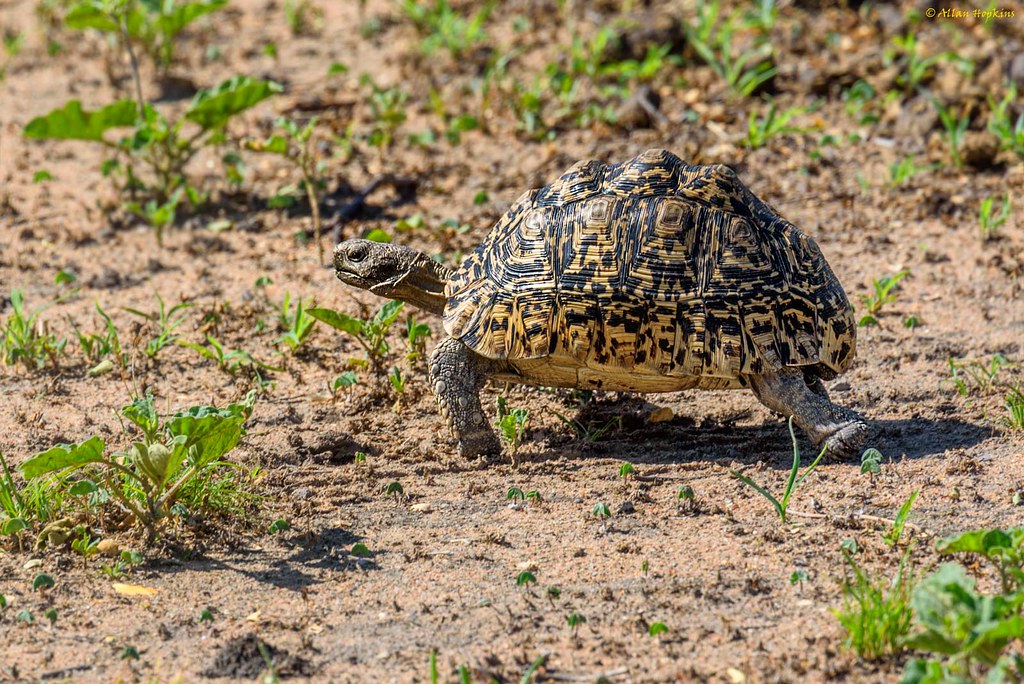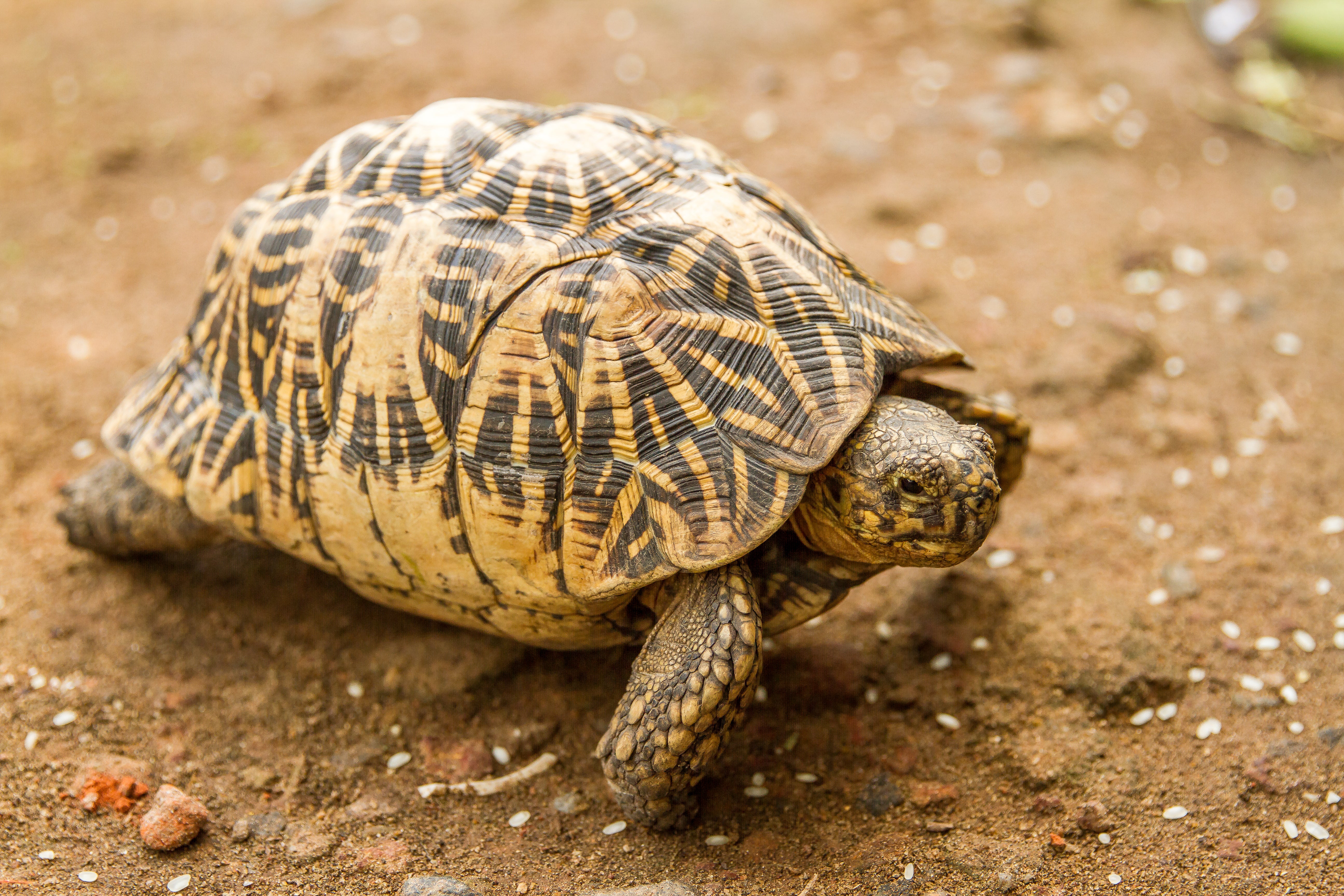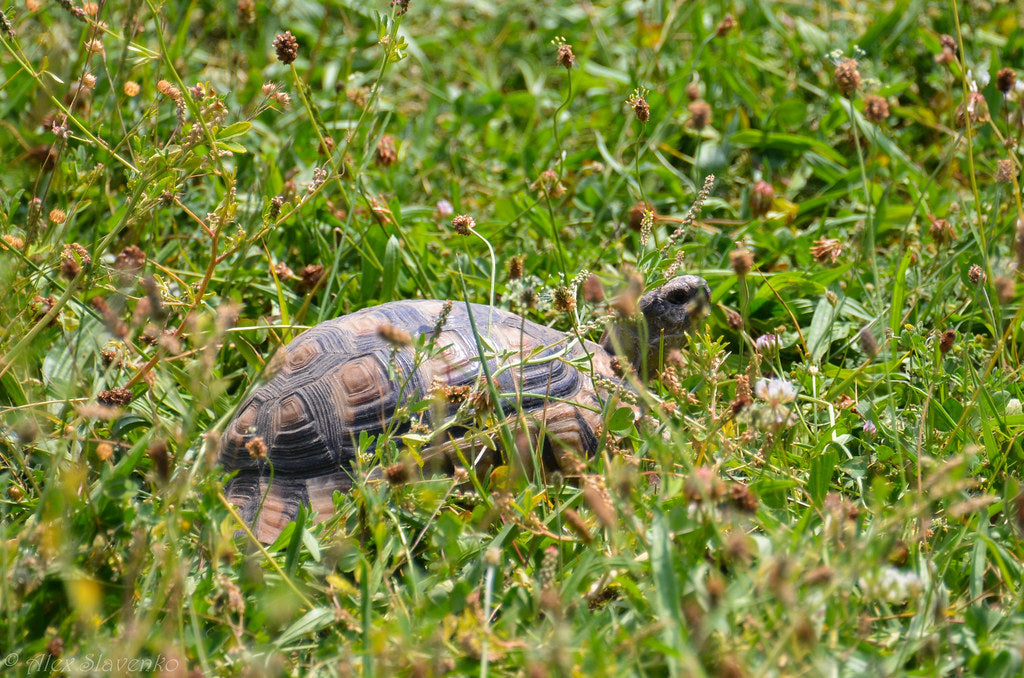Leopard tortoises (Stigmochelys pardalis) are a large tortoise species native to southeastern Africa. They can be found in a variety of habitats, from semi-desert and scrub to grassland and forest.
Leopard tortoises can be as small as 12” long or as large as 28” long, depending on locality and sex. They have highly domed shells, often with pyramided scutes. They have a light brown to yellow base color and dark spots or blotches on the shell. However, pattern is variable, and while the “traditional” leopard tortoise is extremely patterned, some have no pattern at all.
Captive-bred leopard tortoises can make good pets, but due to their potential for enormous size, they are not easy to house. Furthermore, they’re a big commitment: leopard tortoises are capable of living up to 100 years!
How much space do leopard tortoises need?
It is best to house hatchling leopard tortoises in an indoor terrarium while they are small and vulnerable. This should be at least 4’L x 2’W, and the lower 6” or so should be opaque to reduce stress.
Juvenile and adult leopard tortoises should be housed outdoors. In fact, for particularly large individuals, this is a necessity of providing proper housing. The tortoise pen should be at least 10’ x 10’, with 18” high walls. If you can provide larger, all the better! Anti-predator measures should be taken, but escape via climbing or digging is unlikely with this species.
Leopard tortoises do not hibernate, so if you need to house your tortoise indoors temporarily due to prolonged periods of temperatures at or below 60°F, a 4’ x 4’ pen can be suitable as temporary housing, but larger is preferred.
Multiple leopard tortoises can usually be housed together as long as they have extra space, but it is not required for their wellbeing. Males and females should not be housed together unless you intend to breed, and males are likely to fight if housed together.
Do leopard tortoises need UVB?
Yes. Aside from helping provide a day/night cycle and an infinite supply of vitamin D, UVB is also essential to your tortoise’s overall health. If you are housing your tortoise outdoors, then this is not something you need to worry about, because they will get all the UVB they need from sunlight.
If you are housing your tortoise indoors, however, you will need to provide artificial UVB. The best UVB bulbs for leopard tortoises are:
- Arcadia T5 HO 12%
- Zoo Med T5 HO Reptisun 10.0
The bulb should be mounted in the Arcadia ProT5 or Vivarium Electronics fixture at 17-18” above the tortoise’s shell. The UVB bulb and fixture should be roughly half the total length of the enclosure.
Because a large enclosure is required for leopard tortoises, if you are housing yours indoors, a single UVB bulb will not be enough to sufficiently illuminate the enclosure. Add a strong 6500K LED or T5 HO fluorescent grow light to energize your tortoise and better simulate daylight.
All lighting should be on for 14 hours/day during summer and 10 hours/day during winter.
What basking temperatures do leopard tortoises need?
If you are housing your leopard tortoise outdoors, make sure part of the pen is shaded. Night temps as low as 60°F are tolerated well, but it’s good to provide a heated tortoise “house” maintained at 60-70°F for them to use at night if the weather gets any cooler.
If you are housing your leopard tortoise indoors, they will need a basking temperature around 95°F, with a cool/shaded area on the other side of the enclosure between 75-85°F. Heating should be turned off at night. Temperature should be measured with digital probe thermometers.
Use a cluster of halogen heat lamps placed on one side of the enclosure to create a basking area large enough to evenly heat your tortoise’s entire shell. These bulbs should be mounted at least 8” above your tortoise’s shell to prevent burns from close proximity. Do not use ceramic heat emitters (CHEs), heat mats, red bulbs, or blue bulbs, as these are not as effective.
What humidity levels do leopard tortoises need?
As an arid species, leopard tortoises can survive fairly low humidity levels, but preferred average humidity is believed to be between 40-50%. They also need access to areas of higher humidity to stay hydrated. Indoors, one of the best ways to do this is by offering a humid hide for the tortoise to use as needed. This is particularly important for youngsters! Humidity should be measured by a digital probe hygrometer with the probe in the middle of the terrarium.
For tortoises housed outdoors, it’s a good idea to occasionally hose down the cool side of the pen. Make sure your tortoise’s enclosure is not perpetually wet, as this can cause skin, shell, and respiratory problems!
What substrate is good for leopard tortoises?
It’s ideal to use a substrate that imitates what leopard tortoises naturally live on in the wild. In other words, you’ll need something that resembles sandy soil. If you are housing your tortoise outdoors, then unless you have moist clay soil, what you already have in your yard/pasture is likely fine.
If you are housing your leopard tortoise indoors, we recommend plain topsoil mixed 60/40 with play sand by volume. Substrates should be at least 3” deep and completely replaced every 6 months. Remove poop and urine daily, along with contaminated substrate.
Alternatively, you can use a thick layer of clean timothy, Bermuda, orchard grass, or similar hay for substrate. This will need to be completely replaced daily.
What décor can you use in a leopard tortoise enclosure?
It’s terribly boring for a reptile to be stuck in an enclosure with nothing in it except substrate, a hide, and food/water bowls. It doesn’t matter how big the enclosure is if you don’t put things in it for your pet to use and interact with.
Here are some décor ideas that are appropriate for leopard tortoises:
- additional hiding places/burrows
- logs
- live, edible plants
- large, flat stones
You can also shape the substrate into hills to provide an extra challenge. Make sure, however, that your tortoise can’t flip itself over!
For outdoor enclosures, it’s best to plant a variety of drought-tolerant, grazer-resistant edible weeds and grasses. The Tortoise Table is a helpful resource for figuring out which ones are safe to plant.
What do leopard tortoises eat?
Leopard tortoises are herbivorous, which means that they require a high-fiber diet. They do best on a diet of mostly grasses and weeds (90%), with a small amount of “grocery store” greens and other vegetables (10%).
Safe grasses/leaves for leopard tortoises: lawn grass, mulberry leaves, grape leaves, hibiscus leaves, meadow hay, oat hay, orchard hay, timothy, clover, dandelion, nasturtium, geranium
Safe greens and vegetables for leopard tortoises: cactus pads, kale, collard greens, turnip greens, romaine lettuce, squash, white mushrooms, sweet potato
Edible flowers like nasturtium, dandelions, geranium, roses, and hibiscus are great to add for variety and extra vitamins.
Food should be offered daily, placed on a plate or tray to prevent substrate ingestion. If your tortoise is starting to look chubby, reduce the amount of food that you offer per day.
Supplements
You will also need calcium and vitamin supplements to prevent your tortoise from developing a potential deficiency. A little bit of Mazuri grassland tortoise formula or Zoo Med Natural Grassland Tortoise Food hydrated and mixed into your tortoise’s salad is a good way to make sure your tortoise is getting enough vitamins.
You will also need to keep a cuttlebone inside the enclosure at all times as a source of calcium.
Water
Of course, don’t forget a water bowl for your tortoise to drink from! To keep your leopard tortoise hydrated, offer a shallow “puddle” of water for them to drink from. Hatchling should be soaked (supervised) 1-2x/week. The water should be no deeper than your tortoise’s elbows.
Change the drinking water daily and scrub the bowl with a reptile-safe disinfectant weekly.
Do leopard tortoises like to be handled?
Leopard tortoises should not be picked up when it’s not necessary, as they get very stressed when their feet aren’t on the ground. However, they do respond well to hand-feeding and gentle head rubs or shell rubs.
*This care sheet contains only very basic information. Although it’s a good introduction, please do further research with high-quality sources to obtain additional information on caring for this species.
"Leopard Tortoise (Stigmochelys pardalis), male" by Allan Hopkins is licensed under CC BY-NC-ND 2.0




Leave a comment
This site is protected by hCaptcha and the hCaptcha Privacy Policy and Terms of Service apply.